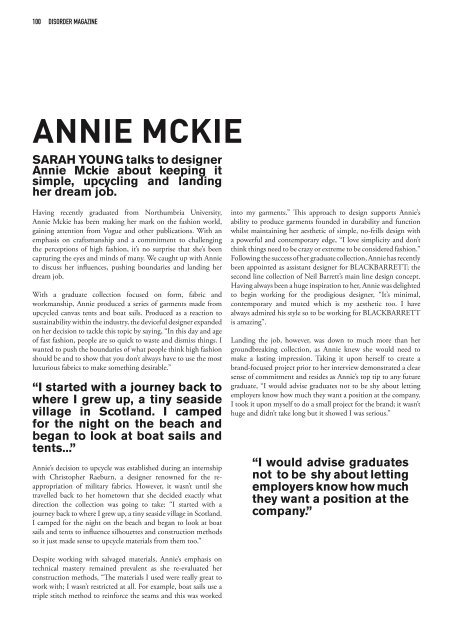GRADUATE FASHION WEEK SHAY D PETER JENSEN FESTIVALS ALEX PRITCHARD
DM_GFW_Special_Final_062016
DM_GFW_Special_Final_062016
Create successful ePaper yourself
Turn your PDF publications into a flip-book with our unique Google optimized e-Paper software.
100 DISORDER MAGAZINE<br />
ANNIE MCKIE<br />
SARAH YOUNG talks to designer<br />
Annie Mckie about keeping it<br />
simple, upcycling and landing<br />
her dream job.<br />
Having recently graduated from Northumbria University,<br />
Annie Mckie has been making her mark on the fashion world,<br />
gaining attention from Vogue and other publications. With an<br />
emphasis on craftsmanship and a commitment to challenging<br />
the perceptions of high fashion, it’s no surprise that she’s been<br />
capturing the eyes and minds of many. We caught up with Annie<br />
to discuss her influences, pushing boundaries and landing her<br />
dream job.<br />
With a graduate collection focused on form, fabric and<br />
workmanship, Annie produced a series of garments made from<br />
upcycled canvas tents and boat sails. Produced as a reaction to<br />
sustainability within the industry, the deviceful designer expanded<br />
on her decision to tackle this topic by saying, “In this day and age<br />
of fast fashion, people are so quick to waste and dismiss things. I<br />
wanted to push the boundaries of what people think high fashion<br />
should be and to show that you don’t always have to use the most<br />
luxurious fabrics to make something desirable.”<br />
“I started with a journey back to<br />
where I grew up, a tiny seaside<br />
village in Scotland. I camped<br />
for the night on the beach and<br />
began to look at boat sails and<br />
tents...”<br />
Annie’s decision to upcycle was established during an internship<br />
with Christopher Raeburn, a designer renowned for the reappropriation<br />
of military fabrics. However, it wasn’t until she<br />
travelled back to her hometown that she decided exactly what<br />
direction the collection was going to take: “I started with a<br />
journey back to where I grew up, a tiny seaside village in Scotland.<br />
I camped for the night on the beach and began to look at boat<br />
sails and tents to influence silhouettes and construction methods<br />
so it just made sense to upcycle materials from them too.”<br />
into my garments.” This approach to design supports Annie’s<br />
ability to produce garments founded in durability and function<br />
whilst maintaining her aesthetic of simple, no-frills design with<br />
a powerful and contemporary edge, “I love simplicity and don’t<br />
think things need to be crazy or extreme to be considered fashion.”<br />
Following the success of her graduate collection, Annie has recently<br />
been appointed as assistant designer for BLACKBARRETT; the<br />
second line collection of Neil Barrett’s main line design concept.<br />
Having always been a huge inspiration to her, Annie was delighted<br />
to begin working for the prodigious designer, “It’s minimal,<br />
contemporary and muted which is my aesthetic too. I have<br />
always admired his style so to be working for BLACKBARRETT<br />
is amazing”.<br />
Landing the job, however, was down to much more than her<br />
groundbreaking collection, as Annie knew she would need to<br />
make a lasting impression. Taking it upon herself to create a<br />
brand-focused project prior to her interview demonstrated a clear<br />
sense of commitment and resides as Annie’s top tip to any future<br />
graduate, “I would advise graduates not to be shy about letting<br />
employers know how much they want a position at the company.<br />
I took it upon myself to do a small project for the brand; it wasn’t<br />
huge and didn’t take long but it showed I was serious.”<br />
“I would advise graduates<br />
not to be shy about letting<br />
employers know how much<br />
they want a position at the<br />
company.”<br />
Despite working with salvaged materials, Annie’s emphasis on<br />
technical mastery remained prevalent as she re-evaluated her<br />
construction methods, “The materials I used were really great to<br />
work with; I wasn’t restricted at all. For example, boat sails use a<br />
triple stitch method to reinforce the seams and this was worked


